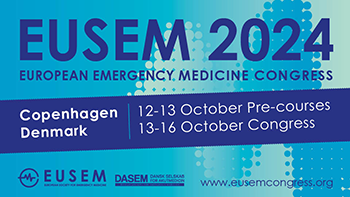
PRESS RELEASE
Embargo: 00.01 hrs CEST on Wednesday 16 October 2024
Seizures caused by children swallowing medications or illegal substances doubled over 15-year period
Copenhagen, Denmark: New data shows that the number of children suffering a seizure after swallowing medications or illegal substances has doubled between 2009 and 2023 in the US. The findings were presented today (Wednesday) at the European Emergency Medicine Congress.
The most common substances involved in these poisonings include over-the-counter antihistamines, prescription antidepressants and painkillers, and illegal synthetic cannabinoids.
Dr Conner McDonald from the University of Virginia School of Medicine told the Congress: “Seizure is one of the most severe symptoms a poisoned patient can experience, and children are particularly vulnerable. Depending on variables such as where a seizure happens, how long it continues and the pre-existing health of the child, seizures can lead to long-term damage or even death.”
Working with Professor Christopher Holstege, Chief of the Division of Medical Toxicology at the University of Virginia School of Medicine, and colleagues, Dr Farah gathered data from the US National Poison Data System on seizures in children and teenagers (under the age of 20 years) that resulted from exposure to any single substance between 1 January 2009 and 31 December 2023.
The National Poison Data System brings together information from the 55 poison centres across the US. These centres are consulted in the most serious cases of poisoning, including poisoning in children that results in seizure.
The researchers analysed the data according to the children’s ages and the substance they had consumed. Overall, they found that cases had increased from 1,418 in 2009 to 2,749 in 2023, corresponding with an average yearly increase of five per cent.
Among children aged between six and 19 years, the number of cases had doubled over the 15-year period. In children under six years, there was a 45% increase in cases over the 15-year period.
The substances responsible for most of this increase include diphenhydramine (an over-the-counter antihistamine commonly used for allergies, hay fever and nasal congestions), tramadol (an opioid prescribed for pain in adults), bupropion (an antidepressant prescribed for adults and children), and synthetic cannabinoids known as K2 or spice (illegal substances that are man-made and chemically similar to substances found in the cannabis plant).
Dr McDonald explained: “Diphenhydramine can be purchased in the United States in bottles containing 500 or 600 tablets. Bupropion is being more frequently prescribed to treat depression in adults and children. Other legal and illegal drugs can be bought online and shipped around the world. Therefore, these drugs are becoming more available in homes and within the reach of children.”
Speaking before the Congress, Professor Holstege said: “The increase in seizures in children exposed to these drugs is extremely worrying and must be addressed. It’s a stark reminder to parents and carers to store medications safely so that children cannot get hold of them.
“In the US, we also need to have a serious discussion on whether products like diphenhydramine should be sold in containers with such large quantities of pills and whether these products should be contained within blister packs to make it more difficult for children and suicidal individuals to gain access to such a large quantity.”
Dr Barbra Backus is chair of the EUSEM abstract selection committee. She is an emergency physician in Rotterdam, The Netherlands,and was not involved with the research. She said: “The increase in drug poisoning among children is worrysome. Although these data are for the US, we know that drugs are the most common sources of poisoning in children around the world. It is important that we keep looking for safer distribution and storage of medication. Blister packs and child-resistant pill bottles can help, but all drugs, whether they are over the counter, prescribed, or illegal should be kept out of reach or locked away where children cannot access them.
“No parent or carer ever wants to see their child suffer a drug-induced seizure, especially when it could have been prevented.”
(ends)
[1] Abstract no: OA098, “Seizures in Single Substance Pediatric Exposures: Analysis from the United States National Poison Data System” by Conner McDonald, in the Oral Abstracts: Neurology session, 11.00-12.30 hrs CEST, Room 19.
Funding: No external funding.
About European Society of Emergency Medicine (EUSEM)
The European Society for Emergency Medicine (EUSEM) is an academic, medical, non-profit society representing the interests of all healthcare professionals involved in Emergency Medicine across Europe. It has members consisting of 38 National European societies and over 1200 individual members. In total, through the different forms of membership, the society represents over 40000 Emergency Medicine Specialists. The scope of EUSEM is from prehospital to the clinical setting, encompassing the whole pathway for emergency medicine. Since 1994, EUSEM has organised a meeting for its members. The congress now attracts over 3000 participants from 76 countries. Its main objective is to share best practices, and to present the latest research and developments in the field in order to provide the best treatment and care for patients.
